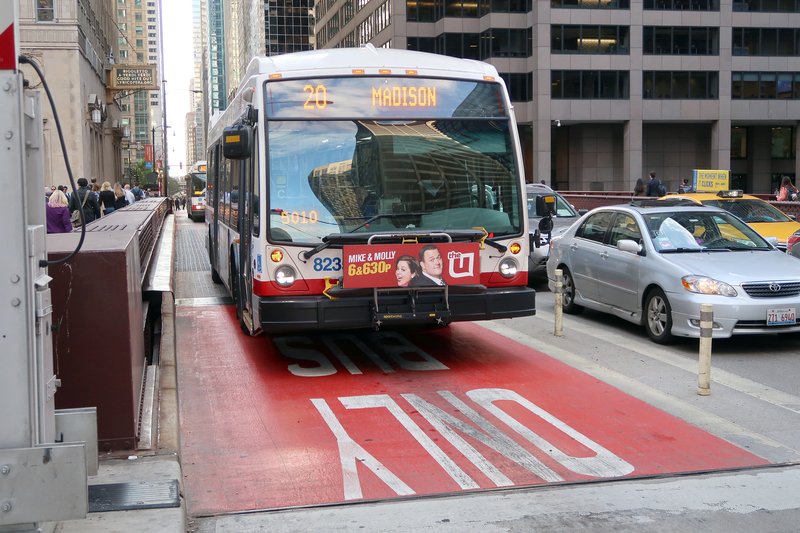Chicago is working on a climate action plan featuring ambitious goals to reduce driving and get more people walking, biking, and riding public transit.
But the current draft lacks firm commitments to redesign city streets and invest in the hard infrastructure needed to support this shift to non-car alternatives. Without these commitments, Chicagoans will not be able track progress on the plan and hold city officials accountable.
Now we need your help to improve the plan.
Review the draft plan on the city’s website and submit a comment by Monday, April 4.
The sections most relevant to walking, biking, and transit fall under Pillar 3: Enable Personal Mobility and Improve Air Quality:
Here is some additional context and background information to inform your comments.
BOLD TARGETS
Chicago is joining 96 cities around the world in updating its Climate Action Plan to reflect the bold action needed to protect and strengthen communities.
The updated climate goals are designed to reduce carbon emissions while also increasing household savings, advancing environmental justice, and improving community health. Transportation is the leading contributor to greenhouse gas emissions statewide and nationally.
The good news is Chicago is on the right track by giving priority to multimodal transportation within the context of the plan. Transportation is often overlooked in these plans in favor of energy and development issues. When transportation comes up, it’s often solely focusing on electric vehicles and their charging infrastructure.
Thankfully, Chicago thus far is not making these mistakes. The transportation section includes a focus on electrifying private vehicles and transit fleets, but also strategies for reducing emissions by driving less and supporting cleaner modes.
Here are some goals highlighted in the plan:
- Increase CTA ridership by 20 percent by 2030 to reduce fossil fuel-based traffic
- Invest in infrastructure, policies, and programs that enable Chicagoans to walk, bike, take public transit, or use shared micromobility for 45 percent of all trips by 2040
- Expand high-quality and low-stress on-street bikeways and off-street trails to reduce total annual fossil fuel-based traffic by 50 million vehicle miles per year
- Increase Divvy and shared micromobility trips 30 percent by 2030, reducing fossil-based traffic by 2.2 million miles per year
These are ambitious targets that go beyond previous commitments. They rightfully emphasize the need to reduce driving by transforming the city’s transportation network and development patterns.
WEAK COMMITMENTS
Unfortunately, the draft plan does not go far enough in explaining how the city will meet these targets. Critical infrastructure like bus lanes and bike lanes are mentioned but there are no commitments to build out connected networks.
Here are more details on what’s missing in two key areas.
Bike lanes: The plan mentions the value of physically separating people biking from car and truck traffic. Study after study shows that people will bike for transportation more regularly if we make our infrastructure safer and more seamlessly connected.
Miles of protected bike lanes is listed as a performance metric in the plan. But how many miles of PBLs should be the goal? Over what period? What about upgrading existing low-quality bike lanes?
All we get is a soft commitment to 50 miles of “bike lane network expansion” and an unclear timeline.
Currently, Chicago has no bike plan and the transportation department has said there is “no need for a citywide plan at this time.” Chicago’s Streets for Cycling 2020 plan was developed in 2012 and is no longer guiding network planning.
Recommended changes in the plan: The plan should include an ambitious mileage goal for concrete protected bike lanes by 2030. This should come with a commitment to develop a citywide bike plan so the goal can be considered in the context of a connected network.
Bus Lanes: Unfortunately, the plan mentions transit lanes only once alongside a “suite of policies that will be explored to improve transit comfort and convenience.”
Bus lanes are not something that needs to be piloted or explored. When deployed efficiently, they have proven to boost bus speed and reliability, increase ridership, and make streets safer for everyone. More reliable and efficient buses are shown to increase ridership and will get more people out of cars.
Recommended changes in the plan: The plan should include a mileage goal for bus lanes by 2030. This should come with a commitment to develop a citywide bus network plan so the goal can be considered in the context of a connected network.
TAKE ACTION
If you live in Chicago, you can submit comments on the draft plan by Monday, April 4.
Key sections for walking, biking, and transit fall under Pillar 3: Enable Personal Mobility and Improve Air Quality, specifically strategy 1 to grow CTA ridership and strategy 4 to invest in multimodal infrastructure.

